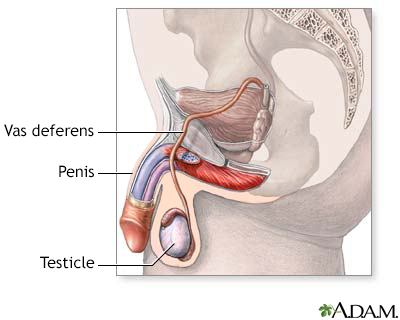Pregnancy SmartSiteTM
Ejaculation retrograde; Dry climax DefinitionRetrograde ejaculation occurs when semen goes backward into the bladder. Normally, it moves forward and out of the penis through the urethra during ejaculation. CausesRetrograde ejaculation is uncommon. It most often occurs when the opening of the bladder (bladder neck) does not close. This causes semen to go backward into the bladder rather than forward out of the penis. Retrograde ejaculation may be caused by:
SymptomsSymptoms include:
Exams and TestsA urinalysis that is taken soon after ejaculation will show a large amount of sperm in the urine. TreatmentYour health care provider may recommend that you stop taking any medicines that may cause retrograde ejaculation. This can make the problem go away. Retrograde ejaculation that is caused by diabetes or surgery may be treated with drugs such as pseudoephedrine or imipramine. Outlook (Prognosis)If the problem is caused by a medicine, normal ejaculation will often come back after the drug is stopped. Retrograde ejaculation caused by surgery or diabetes often can't be corrected. This is most often not a problem unless you are trying to conceive. Some men do not like how it feels and seek treatment. Otherwise, there is no need for treatment. Possible ComplicationsThe condition may cause infertility. However, semen can often be removed from the bladder and used during assistive reproductive techniques. When to Contact a Medical ProfessionalContact your provider if you are worried about this problem or are having trouble conceiving a child. PreventionTo avoid this condition:
ReferencesBhasin S, Basson R. Sexual dysfunction in men and women. In: Melmed S, Auchus, RJ, Goldfine AB, Koenig RJ, Rosen CJ, eds. Williams Textbook of Endocrinology. 14th ed. Philadelphia, PA: Elsevier; 2020:chap 20. McMahon CG. Disorders of male orgasm and ejaculation. In: Partin AW, Domochowski RR, Kavoussi LR, Peters CA, eds. Campbell-Walsh-Wein Urology. 12th ed. Philadelphia, PA: Elsevier; 2021:chap 71. Niederberger CG, Ohlander SJ, Pagani RL. Male infertility. In: Partin AW, Domochowski RR, Kavoussi LR, Peters CA, eds. Campbell-Walsh-Wein Urology. 12th ed. Philadelphia, PA: Elsevier; 2021:chap 66. Schlegel PN. Clinical management of male infertility. In: Robertson RP, ed. DeGroot’s Endocrinology. 8th ed. Philadelphia, PA: Elsevier; 2023: chap 113. | |
| |
Review Date: 1/1/2023 Reviewed By: Kelly L. Stratton, MD, FACS, Associate Professor, Department of Urology, University of Oklahoma Health Sciences Center, Oklahoma City, OK. Also reviewed by David C. Dugdale, MD, Medical Director, Brenda Conaway, Editorial Director, and the A.D.A.M. Editorial team. The information provided herein should not be used during any medical emergency or for the diagnosis or treatment of any medical condition. A licensed medical professional should be consulted for diagnosis and treatment of any and all medical conditions. Links to other sites are provided for information only -- they do not constitute endorsements of those other sites. No warranty of any kind, either expressed or implied, is made as to the accuracy, reliability, timeliness, or correctness of any translations made by a third-party service of the information provided herein into any other language. © 1997- A.D.A.M., a business unit of Ebix, Inc. Any duplication or distribution of the information contained herein is strictly prohibited. | |

 Male reproductive ...
Male reproductive ...
